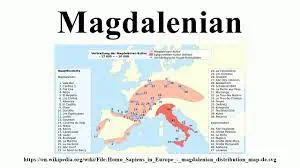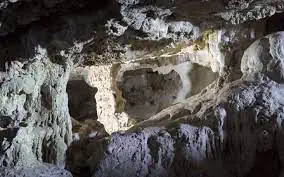Spaniards, Portuguese have completely separate lineages from Africans across the Straights of Gibraltor
 Spaniards have long been considered to share a strong genetic link to North African populations.
Spaniards have long been considered to share a strong genetic link to North African populations.
Now, the Max Planck Institute in Leipzig, Germany, considered to be the gold standard on all things prehistoric genetics, has found that pre-Ice Age populations on the Iberian Peninsula were completely isolated.
A wave of human population expansion spread from the Levant (present day Israel) across Europe 45,000 years ago. The Gravettian culture flourished in central Europe, followed by the Magdelanians and later, the Solutreans further to the West. A Glacial Maximum occurred between 25,000 to 19,000 years ago wiping out the central European populations.
Researchers were unsure what became of the Solutreans and Magdelanians. They have been trying to solve the mystery for decades.
See our article, Subspecieist, Jan. 2022, “Solutreans likely 1st in N. America 23kya, now evidence their Gravettian ancestors were 1st to use footwear.”
Among the researchers that have tackled the issue, the Field Museum for anthropology in Chicago.
J.P. Brown, Field Museum Curator (YouTube, 2013):
 I don’t know if you’ve ever had this thing that’s an itch because something is wrong, and it needs to get fixed, and the longer you leave it, the more irritating it is. Magdalenian skull has been like that. It’s been a burr under my saddle for 10 years.
I don’t know if you’ve ever had this thing that’s an itch because something is wrong, and it needs to get fixed, and the longer you leave it, the more irritating it is. Magdalenian skull has been like that. It’s been a burr under my saddle for 10 years.
Background:
Although previously referred to as “Magdalenian Girl,” Field Museum Curator of Biological Anthropology, Dr. Robert Martin, has established that this specimen was likely an adult woman. Found in a cave in France in 1911, many myths and legends have been built around the story of Magdalenian Woman. One thing we do know for sure is that in 1926, Henry Field purchased the skeleton in New York City, packed it in his suitcase and returned to Chicago on a train. Since then the Field Museum has continued to learn new things about Magdalenian Woman, human culture and the world in which we live.
The Max Planck Institute sent out a press release, March 4. Study authors include, Sandra Jacobs, Dr. Wolfgang Haak and Vanessa Villalba-Mouco (photo):
Oldest human genome from southern Spain: A human genome from the Ice Age refuge in southern Spain
Abstract:
 A new study reports on genomic data from a 23,000-year-old individual who lived in what was probably the warmest place of Europe at the peak of the last Ice Age. The oldest human genome recovered from the southern tip of Spain adds an important piece of the puzzle to the genetic history of Europe.
A new study reports on genomic data from a 23,000-year-old individual who lived in what was probably the warmest place of Europe at the peak of the last Ice Age. The oldest human genome recovered from the southern tip of Spain adds an important piece of the puzzle to the genetic history of Europe.
Background:
An international team of researchers has analysed ancient human DNA from several archaeological sites in Andalucía in southern Spain. The study reports on the oldest genome to date from Cueva del Malalmuerzo in southern Spain, as well as the 7,000 to 5,000-year-old genomes of early farmers from other well-known sites, such as Cueva de Ardales.
The Iberian Peninsula plays an important role in the reconstruction of human population history. As a geographic cul-de-sac in the southwest of Europe, it is on one hand considered a refuge during the last Ice Age with its drastic temperature fluctuations. On the other hand, it may have been one of the starting points for the recolonisation of Europe after the glacial maximum. Indeed, previous studies had reported on the genomic profiles of 13,000 to 8,000-year-old hunter-gatherers from the Iberian Peninsula and provided evidence for the survival and continuation of a much older Palaeolithic lineage that has been replaced in other parts of Europe and is no longer detectable.
From Yahoo News, March 1,
We thought the first hunter-gatherers in Europe went missing during the last ice age. Now, ancient DNA analysis says otherwise
 Our new results show the hunter-gatherers of Central and Southern Europe did disappear during the last ice age. However, their cousins in what is now France and Spain survived, leaving genetic traces still visible in the DNA of Western European peoples nearly 30,000 years later…
Our new results show the hunter-gatherers of Central and Southern Europe did disappear during the last ice age. However, their cousins in what is now France and Spain survived, leaving genetic traces still visible in the DNA of Western European peoples nearly 30,000 years later…
the genetic profile of Southwestern Gravettian populations again and again for the next 20,000 years in Western Europe. We saw this first in their direct descendants (known as Solutrean and Magdalenian cultures). These were the people who took refuge and flourished in Southwestern Europe during the ice age…
Southwest Gravettian populations… Direct link to the first modern humans that settled Europe
Continuing:
Remarkably, the 23,000-year-old remains of a Solutrean individual from Cueva de Malalmuerzo in Spain allowed us to make a direct link to the first modern humans that settled Europe.
However, there was no genetic link to African populations, including North Africans which stunned the researchers.
From the Max Planck release:
 Interestingly, the authors did not find any genetic link between the southern Iberian Peninsula and North Africa – despite a distance of only 13 kilometres across the Mediterranean Sea, and parallels in the archaeological record. “In Malalmuerzo, we found no evidence of a genetic contribution from North African lineages, and conversely, there is no evidence of a genetic contribution from southern Spain in the genomes of the 14,000-year-old individuals from the Taforalt cave in Morocco”, adds Gerd-Christian Weniger from the University of Cologne.
Interestingly, the authors did not find any genetic link between the southern Iberian Peninsula and North Africa – despite a distance of only 13 kilometres across the Mediterranean Sea, and parallels in the archaeological record. “In Malalmuerzo, we found no evidence of a genetic contribution from North African lineages, and conversely, there is no evidence of a genetic contribution from southern Spain in the genomes of the 14,000-year-old individuals from the Taforalt cave in Morocco”, adds Gerd-Christian Weniger from the University of Cologne.
Spaniards and Portuguese today do have some genetic lineages stretching back to North Africa. However, that comes from later population incursions and admixing events. The researchers identified between 4 to 20% of the genome of Italians, Greeks and Spaniards to be from North Africa. However, they also noted only small traces of Sub-Saharan ancestry was found in southwest Europeans.
From a 2013 study published by the National Academy of Sciences:
“The higher level of genetic variation in Southern Europeans reflects gene flow from North Africa during historical times. We’re talking about the last 2,000 years, really from the Middle Ages during which there was occupation in Spain,” said study co-author Carlos Bustamante, a geneticist at Stanford University.
Some argued that this genetic diversity came from the Moorish occupation of the Iberian Peninsula in southwestern Europe or the Roman contact with North African civilizations such as Carthage around 2,000 years ago.
Note – Turismo de Granada, Cueva de Malamuerzo.

One question is did these people have Neanderthal genetics too?
We know Neanderthals were once in what is now Spain.
It would be surprising if they had no Neanderthal genetics.
I’m submitting my application to be Vanessa’s new lab partner.
What little I know about paleoanthropology has focused on the rise of humanity, not so much in the brief time after Homo sapiens acquired world domination. That’s given me an inkling that we are dealing with massive scales of time and populations that few individuals in their tiny span can really wrap their head around.
It’s 8500 miles from South Africa to China and 1.5 million years between Turkana Boy and the Denisovan girl in Altai.
Compare: An observer would have a hard time gleaning an understanding of Seti’s Egypt by studying Jamestown and they’re only separated by 3300 years and 6000 miles. And there are written records.
Disparate populations have probably ebbed and flowed through the Iberian peninsula scores of times between the last Neanderthal and 23,000 years ago. I would be shocked if any extraordinary markers of their existence remained.
Genetic hominin tracing has mostly been helpful because some groups of backward Africans seem to have been time capsule frozen for just about a gazillion years.
Yes, of course they had Neanderthal. Okay, the 60,000 year old woman found in Czechia had I believe 6%. The Homo sapien found in Croatia dated 20,000 years ago was 16%. And Utzi the Iceman, from 2000 years ago, had 4.5%. I think I’ve got those percentages about right.
I do know Stringer likes to use the Croatia example and say that he was 1/12th Neanderthal, meaning one of his great grandparents was a full Neanderthal. That’s pretty mind-blowing if you think about it. Give that Croatian man a 23 and Me test, and it’d be like “hey look, great grandpops was full-blooded Neanderthal.”
There’s lots of neanderthal to go around to be sure, some individuals much more than others. I was only saying that migrating populations over long periods have pretty much dispersed the genetic footprint of past groups that used to live on the same real estate. Except for some isolated pockets of sub-Saharan Africans.
Maybe I missed something, but I didn’t see anything showing Iberian populations only 15,000 years post-extinction had any more Neanderthal genes than anywhere else.
But to tell the truth, nobody should listen to me much about this micro population stuff. It makes me dizzy. Give me Homo habilis any time.
https://www.oldest.org/geography/haplogroups/